A 59-page report from the U.S. Government and Accountability Office (GAO) underpins much of the updated information policy and guidelines that are now present in all branches of the U.S. military. This report is the big "tell" about the direction of the DoD's thought process about the "opportunities and threats to the DoD's national security mission." Familiar mis-,dis-, and mal-information terms like the "cognitive dimension" of the information environment as well as "cognitive security," is discussed. The goal of the report is to help our DoD "protect the information environment." GAO administered questionnaires to the leadership of 25 DoD organizations "asking about the information environment's effect on their organizations." The performance audit was conducted from January 2021 to September 2022.
UncoverDC has reported extensively on the government's incursions into the domain of information and free speech. Cognitive infrastructure is now a common and consistent construct in the lexicon of agencies like CISA, the FBI, the DOJ, etc. While it is understandable for the DoD to want to protect our national security interests, trust in our government is at an all-time low. Many Americans feel they are no longer able to freely digest and disseminate information that agrees with their worldview. In many cases, as understood most recently because of the Twitter files and the seminal free speech case, Missouri v. Biden, Americans realize that much of the information on the internet is and has been highly controlled and non-conforming perspectives suppressed.
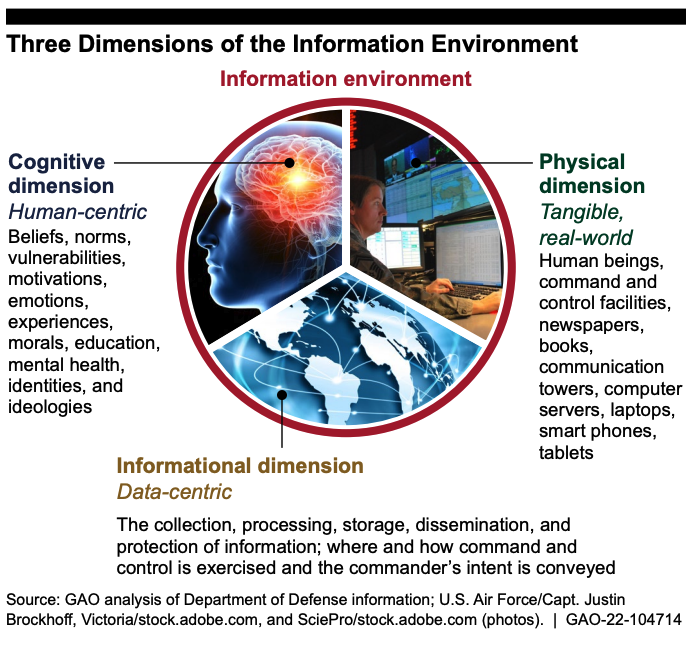 GAO Report on Information/https://www.gao.gov/assets/gao-22-104714.pdf
GAO Report on Information/https://www.gao.gov/assets/gao-22-104714.pdf
GAO Report: Cognitive Security
Featured prominently on the first page of the report is the now omnipresent mis-, dis-, and mal-information campaign. The GAO investigation found a "proliferation of ubiquitous [and malign] information, misinformation, disinformation, and malinformation" that has "prompted defense experts to begin examining the concept of cognitive security." Thus is introduced a relatively new term into the government's national defense lexicon— "cognitive security." Cognitive security is a subset of "cognitive infrastructure." This type of infrastructure has often been weaponized against Americans on social media platforms and in the media.
Cognitive resilience is another widely used term to describe a teachable process that helps "cultivate critical thinking and media literacy through education, as well as the development of tools that can provide real-time identification and defense for people and organizations encountering sophisticated influence efforts."
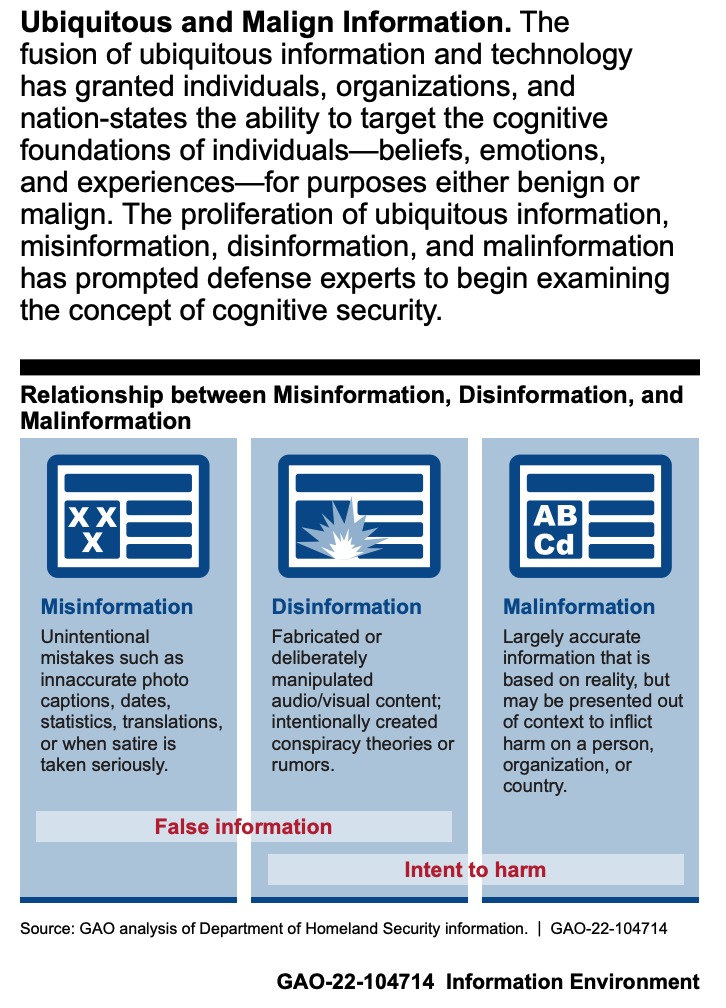 GAO report/https://www.gao.gov/assets/gao-22-104714.pdf
GAO report/https://www.gao.gov/assets/gao-22-104714.pdf
On one hand, the threat to our national security of poorly vetted information is real in the now information-rich virtual environment. Foreign actors work daily to infiltrate and influence public opinion, so it would not be far-fetched to believe they have their sights trained on military operations. The GAO highlights a number of "cyberspace threats, information or intelligence collection threats, influence threats, and EMS threats that adversely affect DoD personnel and capabilities," as featured in the graphic below:
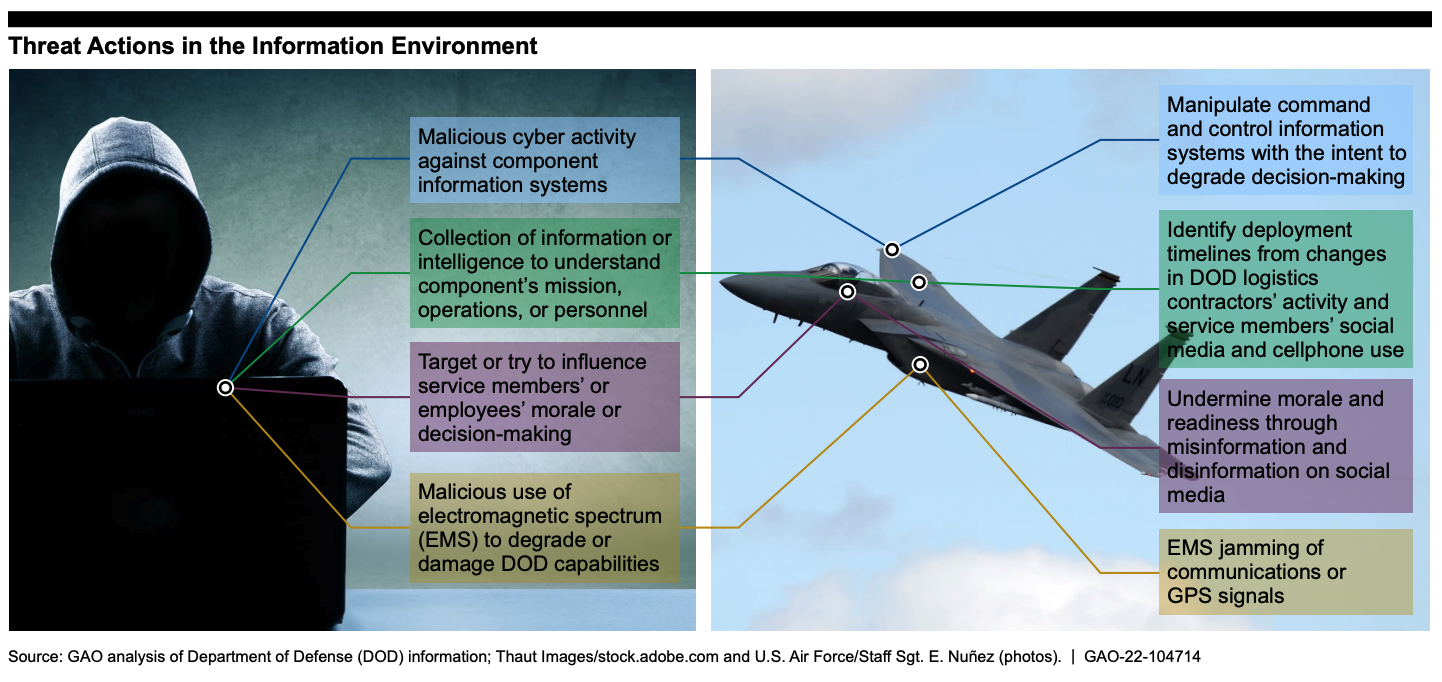 GAO Report/https://www.gao.gov/assets/gao-22-104714.pdf
GAO Report/https://www.gao.gov/assets/gao-22-104714.pdf
The GAO report references a number of concepts and technologies that are now making their way into public awareness, such as fifth-generation wireless technologies that are "engineered to greatly increase the speed and responsiveness of wireless networks." Such technology is increasingly the building block of an "extended reality" and "The Internet of Things" (internet-capable devices like phones and wearable devices). These technologies, according to the report, can have "positive benefits or negative consequences for the DoD." These tools have the potential to distribute information rapidly, which impacts the ability to do damage control should bad information be disseminated. As such, all military branches must be properly and uniformly trained in a relatively new "doctrine" that reflects the "fundamental nature of information in joint operations."
Again, the threats are real and should not be underestimated. There is a stark difference between the "industrial age capabilities" of our military and the "information age vulnerabilities" our service members must now confront. No doubt, we are changing how we fight because of our information-rich world. As stated in the report with its accompanying graphic:
"These information-age activities allow adversaries to target our capabilities and adversely affect military business functions and missions in ways that offset the industrial-age advantages we have developed, as shown in figure 2.
As a result of these activities, DoD must continue to find ways to protect information, systems, and minds through disparate security fields, such as information security, operations security, cybersecurity, physical security, and cognitive security."
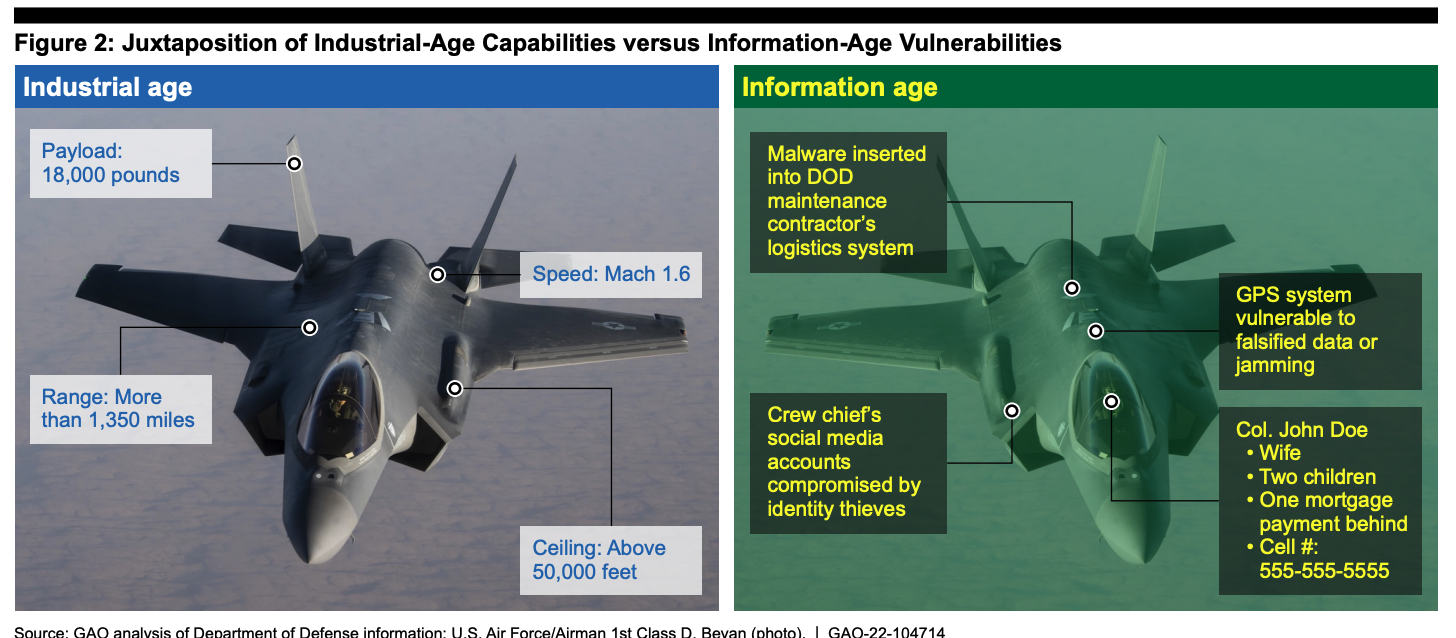 Page 2 GAO Report/https://www.gao.gov/assets/gao-22-104714.pdf
Page 2 GAO Report/https://www.gao.gov/assets/gao-22-104714.pdf
The Risks of Coordinated and Controlled Information
We are now a much more skeptical nation with regard to our First Amendment rights, and rightfully so. As previously stated, our government has waded into the territory of tyranny in the last few years, waging war with what most Americans hold dear; their freedom to think and speak freely, whether in person or on the internet.
Concerning our national security interests, the discussion is necessarily contextual. Had our government not pushed the boundaries of what has now come to be known as allowed speech, we might not be concerned over DoD policies that seek to explore how "adversaries can target the cognitive foundations of individuals." It is one thing to be guarded against the informational threats of foreign actors, but it is quite another to target and/or label American citizens or maybe even our own service members with the same level of perceived threat.
Just two years ago, our own DoD, military service branches, and CDC worked together with big tech to #killthevirus in service of the promotional uptake of the COVID-19 mRNA shots and other government-sponsored research and treatments. Multiple town halls run by the U.S. Army led by Dr. Steven Cersovsky, Senior Advisor, MEDCOM and deputy director of the Army Public Health Center, pushed the vaccines, masking, and social distancing policies. In tandem, every branch of the military distributed controlled social media messaging on the subject. They also pushed shots for children. To wit, uniform and controlled messaging put out by the DOD is not always as neutral as they might have you believe. More importantly, millions listened and complied, in some cases, to their detriment.
Ubiquitous and Malign Information: Who Decides What That Is?
Not for nothin', the GAO report, in the section on "Ubiquitous and Malign Information" on pages 6-8, explores the ramifications of a DoD strategy that ignores mis-, dis-, and mal-information. The section speaks of a "hypothetical example" of "micro-targeting" by foreign actors "to identify DoD personnel who may be more susceptible to (un)wittingly sharing sensitive and classified information." Fair enough. However, the same paragraph mentions "targets that are susceptible to disinformation that fits their beliefs, attitudes, and worldviews. This can lead targets to increase their reliance of disinformation and, in some instances, make them resistant to attempts to 'correct' their views causing them to more strongly accept disinformation." It is this potential corrective measure, with "correct" notably between quotation marks, that becomes somewhat concerning. On some level, the use of quotes here means our government recognizes on some level its potential abuse of free speech and a worldview that may deviate from the government's thinking of what that worldview should be. Translated, "We aren't really "correcting" you. This is for your own good. This is national security." The danger of that kind of influence on thought and speech could produce, among other things, military service members whose divergent thinking is not valued and therefore discouraged. In some cases, it is the very act of thinking outside the box that could actually protect our national interests.
One of the more disturbing admissions in the report is found under the Questions for Oversight sub-section. Accountability is explored, meaning GAO asks specifically about the steps DoD should take should a service member behave "unacceptab[ly]" and what action the DoD should take to "manage publicly available information of its personnel, units, and operations."
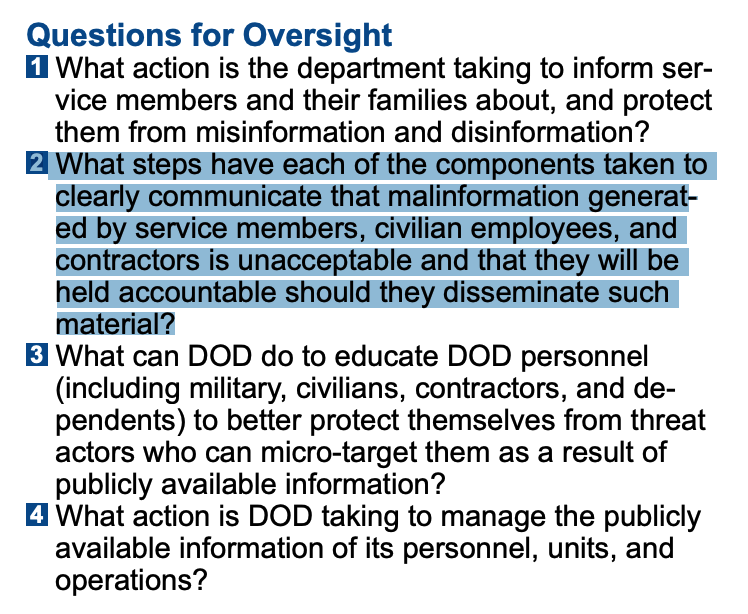 GAO Report/P 8/https://www.gao.gov/assets/gao-22-104714.pdf
GAO Report/P 8/https://www.gao.gov/assets/gao-22-104714.pdf
Again, who decides what speech is acceptable? How sure can military members be that they won't become the target of discrimination and/or disciplinary action should they engage in social media behavior that is not in the realm of a clear threat to national security but that does communicate a divergent thought process or world view? How confident can the American public be that our DoD is not promulgating a social media campaign that doesn't serve American interests in the minds of those whose political and/or cultural worldview may differ from that of any given administration?
Notably, the same section actually addresses "ubiquitous public information" that "can foreshadow a military deployment." It shows some of the ways social media can influence American sentiment. Paired with their captured media partners, coordinated governmental social media messaging can exert influence the public on almost any given campaign. Just look at our current financial and operational involvement in Ukraine. Nothing related to our involvement there has been fully justified by President Biden or Congress to the American people. And yet, here we are. The campaign for Ukraine is reminiscent of the "We are in this together" messaging that was so prevalent during the 2020 pandemic. The result is—in many cases—Americans who fly Ukrainian instead of American Flags outside their homes and on their social media profiles with remarkable conformity.
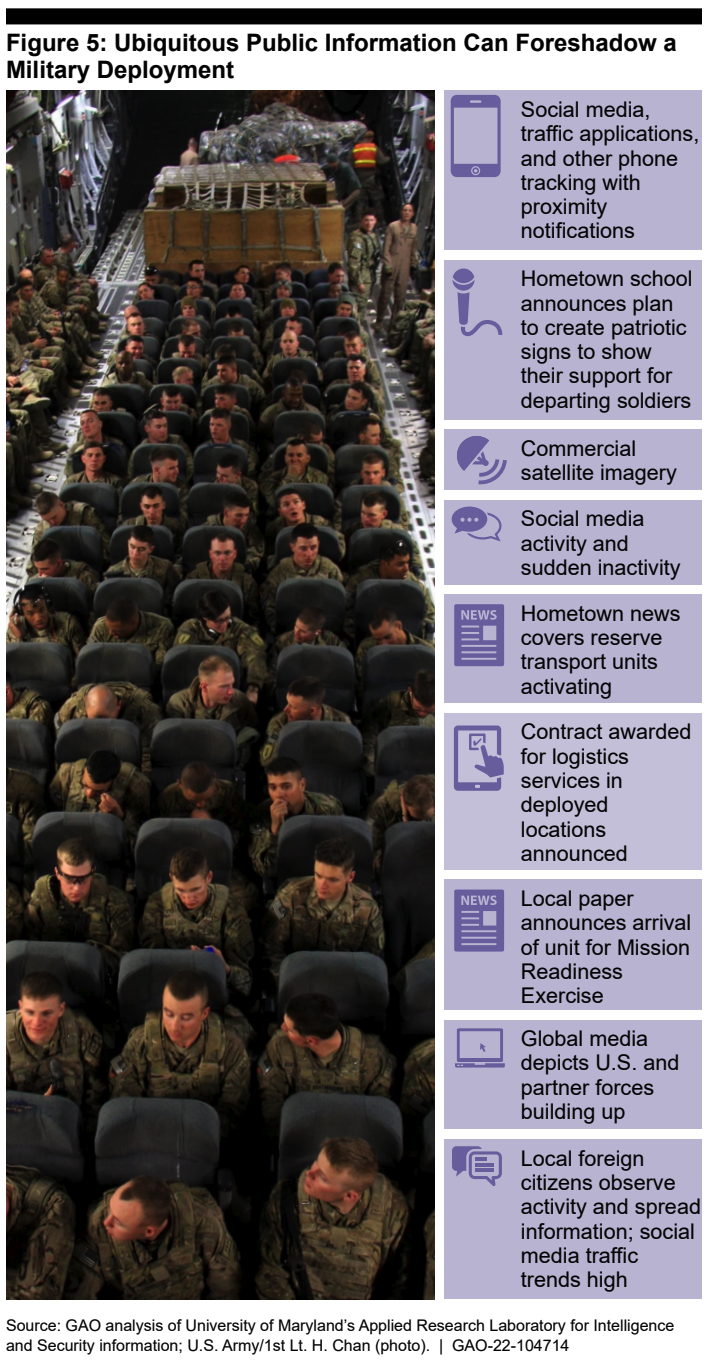 GAO Report/https://www.gao.gov/assets/gao-22-104714.pdf
GAO Report/https://www.gao.gov/assets/gao-22-104714.pdf
All Branches of the Military to Comply With Unified Social Media Policy
The GAO report was influential in the development of guidelines found in all branches of the military. The Department of Defense made public on Jan. 24 an update on its external official presence (EOP) concerning disinformation on social media platforms. Recognizing its ongoing need to integrate social media platforms as an "integral element of DoD strategies to communicate official information publicly in accordance with DoDI 8170.01," this is "the department's first instruction that provided Pentagon-level, departmentwide guidance that specifically addresses the use of social media, according to a U.S. Army article on the subject. Other directives related to speech have been in place for years.
Official Use of Social Media for Public Affairs Purposes (DoDI 5400.17) was first announced on Aug. 12, 2202. The policy refers to the use of "official social media accounts for the sake of transparency and to disseminate information." It applies to "OSD, the Military Departments, the Office of the Chairman of the Joint Chiefs of Staff and the Joint Staff, the Combatant Commands, the Office of Inspector General of the Department of Defense, the Defense Agencies, the DoD Field Activities, and all other organizational entities within DoD. This policy does not apply to social media accounts established for marketing activities by Military Service recruiting commands, in accordance with DoDI 1304.35."
Each branch of the armed forces has its own "Component-specific set of social media regulations" that help create an "environment where trusted information is shared," as stated in the social media handbook for Marines. The guidance for Marines, for example, and in the words of General David H. Berger, Commandant of the Marine Corps encourages Marines to "communicate with precision and consistency based on a common focus and a unified message." Likewise, Navy Units must register their official websites and/or social media channels to communicate official information. Naturally, "operational security" is a key reason such guidelines have been put in place. Official online accounts in all branches of the DoD must be identified as a government organization if the platform allows that identification.
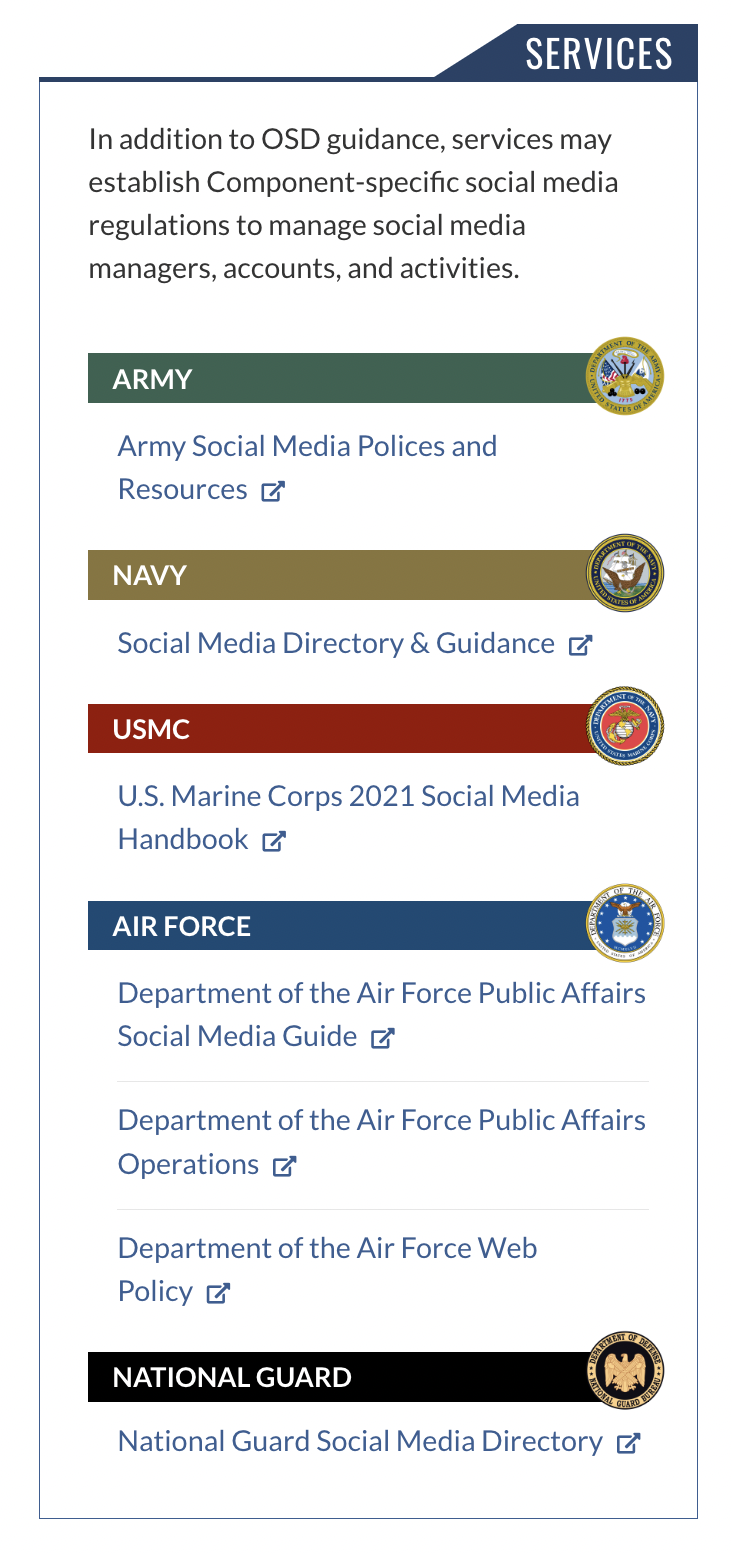 Social Media Policies/Disinformationhttps://www.defense.gov/social-media-policy/
Social Media Policies/Disinformationhttps://www.defense.gov/social-media-policy/
The discussion here is by no means exhaustive. Experience tells us that there is much hidden when it comes to the ways our government is handling information in the public domain. While the DoD absolutely has a right and duty to protect its assets and the American people, there are breadcrumbs laced throughout its guidelines and policies that give pause and reason for concern. There is no doubt a slippery slope down which we are rapidly sliding. There are many warning signs indicating that the disinformation the DoD and other agencies are worried about does not necessarily conform with Americans' deeply seated desire to think and speak freely.


